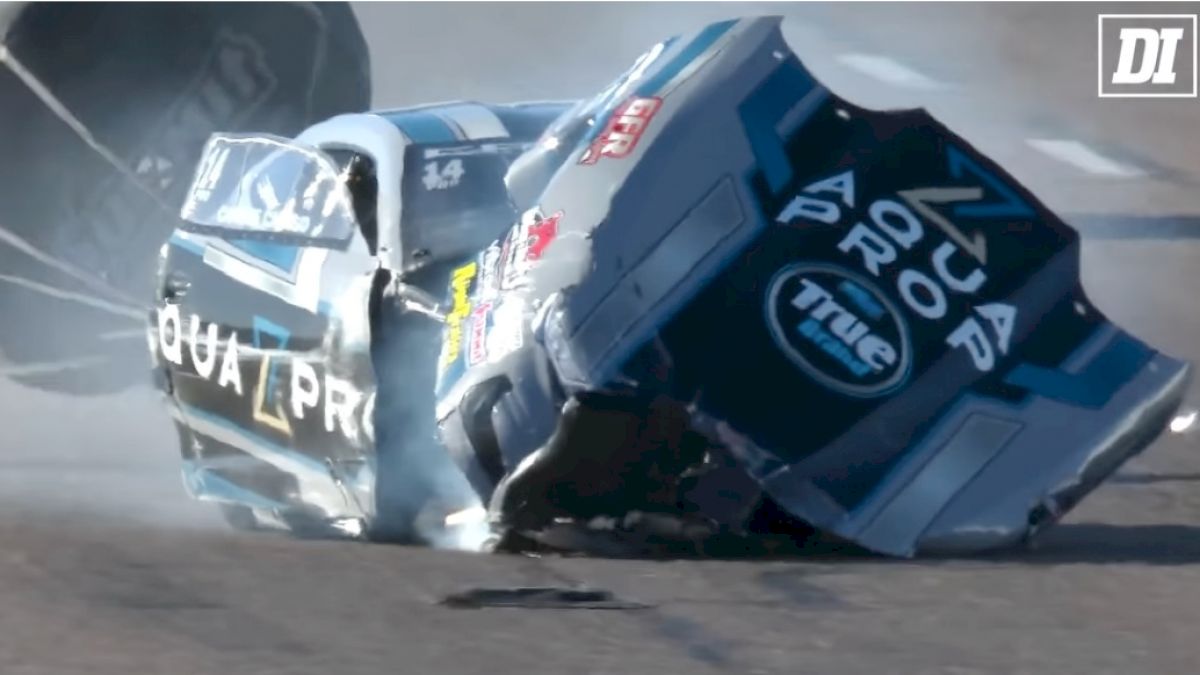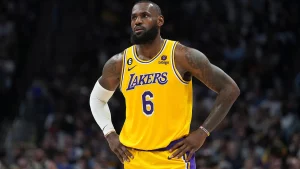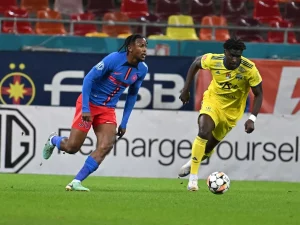
How old is too old in racing? ‘It’s their call. No one else’s’

How old is too old?
As John Force fights for his life in a Richmond intensive care unit, that is one of two harsh-reality questions that are being asked by fans of auto racing and even the racers themselves. The other, of course: Is Force going to be OK? His condition has improved significantly since his frightening, fiery June 23 crash at Virginia Motorsports Park, when his Funny Car’s engine exploded as it crossed the finish line at 302 mph, the Chevy crossing the centerline, slamming into the left concrete guard wall and then careening back across to also hit the right wall.
On Sunday, one week after the crash, John Force Racing posted an update that, after days of struggling to respond to commands, Force had begun communicating, albeit rudimentarily, but had improved enough that he was being moved from a trauma intensive care unit to the neuro ICU.
The road to recovery will be long, but he is indeed on that road. Now, as that trip begins, so has a conversation that is nothing new to the motorsports world. How old is too old to be piloting a racing machine at triple-digit speeds, whether it be in a straight line, turning left or weaving its way around a road course?
“Racers can’t be held to the same calendars as others, whether you are talking about other athletes in other sports or someone who works in another industry, finance, a doctor, whatever,” Mario Andretti explained at Indianapolis Motor Speedway in May. The conversation was about another very fast senior on the circuit, Helio Castroneves, the four-time Indy 500 winner who turned 49 on May 10 and then made his 21st start in the Greatest Spectacle in Racing two weeks later. “Your timeline is your timeline. No one else’s. And along that timeline there are signs that tell you to either keep going or it is time to stop. The question is whether or not you are willing to listen to those signs. I did. Then I didn’t. Then I did again.”
The irresistible Force
Force, a 16-time NHRA Funny Car champion, is inarguably the greatest drag racer who has ever lived. He is also 75 years old. Famously time-defiant, he celebrated his personal diamond jubilee on May 4, directly in between being the number one qualifier at the NHRA Four-Wide Nationals in Charlotte in April and being the finals runner-up at the Route 66 Nationals in mid-May. He has already won twice this year, extending his already-unreachable career record to 157 wins.
“Not bad for an old man,” he joked during a Nitro Alley chat in Charlotte on April 26, pausing his minibike as he made his way from his ride to those of JFR teammates Robert Hight, Austin Prock and Brittany Force, the youngest of his three daughters. “People ask me all the time, when am I going to quit? Man, you’ve been asking me that for years. But when have you ever known me to have any quit in me?”
Never have, never will. And yes, the first time I broached that subject with him was in 2009 for a story about himself and Ashley Force, the oldest of those daughters and herself a then-NHRA Funny Car title contender. The piece was about another Lazarus moment after a horrifically awful crash at the Texas Motorplex in 2007, the same year his protégé, Eric Medlen, had been killed in a test session. Force likely survived his accident because of changes made to his car learned from Medlen’s death. He was 58, but yet somehow went from his body being splayed open and bleeding all over a Dallas drag strip to winning two more NHRA championships.
Two years later, we were talking about the end again. I was with him as he posed naked for ESPN The Magazine’s Body Issue, showing off his scars and burn marks and telling the stories that came with each. The young, sculpted images of Olympians and stick-and-ball athletes were titled “The Bodies We Want.” Force was featured under the headline, “The Body You Don’t Want.”
“You look at it and think, ‘How am I still here? Why am I still here?'” he said to me, his firesuit pulled down around his ankles in his motorcoach, standing in his underwear, squeezing and poking at every nook and cranny-turned-crash story. “This old sequoia tree, I’m 62, but I’m still pretty damn strong. All those scars and all those rings you’d see if you cut me open, they’ve made me stronger. Now people can see it for themselves. Maybe it’ll make them stronger, too.”
That was 13 years ago. He’d just won his 15th championship and added his 16th three years later. Since that story ran, he has won another 27 times, eight of those coming after his 70th birthday. At an age when most adults are having to decide whether or not they should hand over the keys of their sedans, Force has been routinely launching himself via nitromethane at 320 mph and still doing it well.
The race against time
How old is too old? That’s an easy answer to post with an exclamation point on one’s social media timelines while Force is in the ICU, or even one year ago, when he was winless for the first time in a non-pandemic year since 2009. However, it was a much more nuanced debate during most other days, including this season, when he had rebounded off last year’s drought to find his way back into the title fight.
“To me, it is about my personal abilities, my ability to react, my ability to protect myself and to recover should I be in an accident,” Castroneves explained in May, only three years removed from winning his fourth Indy 500 at age 46. “But even more importantly than any of that, it’s asking, ‘Am I putting the racers who compete against me in danger?’ That is the moment when it is time to be done. Instantly. And I believe [the IndyCar paddock] is a place where, if I was in denial, I have friends who would come to me and say, ‘Helio, your edge is gone. We don’t feel safe with you out there, for you or for us.’ At least, I hope they would say that.”
Advanced age had nothing to do with Force’s engine exploding in Virginia, or the unforgiving hardness of the concrete retaining walls that his car bounced off as it slowed to a stop. But to Castroneves’ point, age will certainly play a part in the speediness or lack thereof of what is hopefully a full recovery.
“Telling a racer that they could get hurt or that they are old, and if they get hurt it’s going to take longer to get better, that’s wasting your damn breath,” growled A.J. Foyt in May. “Super Tex” made his first Indy 500 start in 1958 at the age of 23 and his last in 1993, when he was 58. “Risk was the deal when you started off young and that doesn’t change. Common sense was never what we were good at.”
Older by nature
They also don’t operate on common timelines. Racers typically compete much longer than other athletes. That’s not a new development. Even now, during an era when racers are voluntarily retiring earlier than ever, citing the security of money in the bank and the weariness of racing’s ceaseless schedule. Just last month, Martin Truex Jr. announced he was done as a full-time NASCAR driver at year’s end. People reacted with a, “But he’s so young!” Truex is 44, the same age as Tom Brady when he retired, yet people described the seven-time Super Bowl champion as if he was Methuselah.
When Dale Earnhardt finally earned his long-denied Daytona 500 victory in 1998, he was 46. His final and perhaps most amazing win came in the fall of 2000, when he dashed from 18th to first in four laps at Talladega. He was 49.
Al Unser Sr.’s fourth Indy 500 win came five days shy of his 48th birthday. Bobby Allison won the Daytona 500 by edging out his son in 1988 when he was 50 and Davey was 29.
In 1991, Harry Gant became known as “The Old Man in the Olds” when he won four straight NASCAR Cup Series races. He was 51. One year later, “Handsome Harry” set the record as the oldest NASCAR winner at 52.
Hershel McGriff, elected to the NASCAR Hall of Fame in 2023, made his first NASCAR start in the inaugural Southern 500 at Darlington Raceway in 1950 … and his last start in a Pro Series event at Tucson Speedway in 2018, when he was 90. Red Farmer, voted into the Hall one year earlier, still races regularly on the red dirt Talladega Short Track bull ring adjacent to the Talladega Superspeedway in Alabama. He’s 91.
“People love to point guys like Red and brag about how tough he is, and he is,” said Tony Stewart, who retired from his NASCAR career in 2016 at the age of 45 but is now a 53-year-old rookie in the NHRA Top Fuel division, sitting ninth in the standings at the season’s halfway point. “But you can’t applaud a guy for being so tough and awesome for racing into his old age and then rip another guy in another series for doing the same thing. Everyone is different. So everyone’s decision as to when they want to stop racing, that’s of course going to be different, too. It’s their call. No one else’s.”
Say when
Unser Sr. used to tell the story of the moment he knew that he was done.
In 1994 he was attempting to qualify for his 29th Indy 500 with underfunded Arizona Motorsports. During practice he did what he’d always done since 1965. As he flew down the Speedway’s long frontstretch, he glanced up at the scoring pylon to see where he was on the speed charts.
“How many thousands of laps had I run and done that, looking up and then looking back and rolling right through Turn 1?” he recalled during a conversation in 2011. “But this time, when I looked down, I was in the wall. It was a fraction of a second, that was the only difference, but that’s enough to get yourself killed or someone else killed. Right after that, I retired.”
The other four-time Indy 500 winners also had similar moments.
Rick Mears, whom many believed would win another 500 at least, broke his hand during the 1992 race and says he woke up later during that same IndyCar season and for the first time in his racing life thought, “I wonder what we are doing in practice today?” instead of, “This is what I want to do in practice today.” As Mears recalls now: “That’s the moment I knew I’d lost the edge. Once the edge is gone, the drive is gone.” He was only 40.
Foyt hung up his Indy gear one year later. After seeing employee/teammate/youngster Robby Gordon suffer a huge practice crash, 58-year-old Foyt quietly informed Gasoline Alley he was done, running a ceremonial lap and waving to the crowd of 250,000.
“I had damn near died three years earlier at Elkhart Lake,” Foyt recalled of a 1990 road course crash that sent his car flying through the air and embedding itself into the earth like a lawn dart, crushing his legs. After a folder full of surgeries and hundreds of rehab hours, he qualified second for the ’91 500 and finished ninth in ’92. “I said I was going to retire in ’91 but didn’t. I thought about it again in ’92 and didn’t. In ’93, after Robby’s crash, it was like a voice said to me, ‘A.J., you keep pushing this and you know where it’s going to end up, don’t you?'”
Still, most retirements are soft outs at best. Foyt came back and qualified for the inaugural NASCAR Brickyard 400 at Indianapolis Motor Speedway the following year. Truex, as is always the case these days with any driver who has announced their retirement, is quick to correct anyone who uses “the R word” by adding “only from full-time racing.” As Andretti alluded to in his earlier quote, he was coaxed back into an IndyCar for a test session in 2003, nine years after his final 500 start, when, at the age of 63, he went airborne at 223 mph and did multiple horrific flips through Indianapolis’ short chute between Turns 1 and 2. He somehow walked away. Of that moment, Andretti recently said: “I looked really good out there, until I really didn’t. Message received, Indianapolis.”
Richard Petty retired in 1992 at the age of 55. He said that he wishes a voice had spoken to him.
“My last win was in 1984, so that means I raced for another eight years without winning,” he remembered in May. “No one tells you that you’re never going to win again. You just think, ‘Oh, it’ll happen again. It has to.’ Then it doesn’t, and it doesn’t and it doesn’t again. It happened to me, it happened to [David] Pearson, it happened to Cale [Yarborough], it happened to [Darrell] Waltrip, everybody. You don’t quit because it’s all you’ve ever done. It’s who you are, even when you can’t do it like you used to.”
It’s why whenever someone inevitably conjures up some sort of legends of motorsports event, the old guys come out of the woodwork with their helmets. See: the crash-fest 50-plus Fast Masters of 1993 and the Bristol Motor Speedway’s Saturday Night Showdown in 2010, the latter ending when an accident broke the ankle, wrist and pelvis of 56-year-old former NASCAR racer Larry Pearson, the son of David. He has remained affected by the injuries ever since but has also said, “I’d do it again right now.”
The science of hanging on
During a recent episode of the wildly popular Huberman Lab podcast, psychoanalyst Dr. James Hollis delved into this very topic. He wasn’t specifically speaking of aging racers when he said the following, but they are certainly in the group that he was addressing in a conversation that was recorded, fittingly, during the race-crazed month of May.
“Right now, in my practice, I have several men between 60 and 80 … and they’ve been conditioned to work. You get up and you go to work and you do what you’ve done all these years. And then suddenly, you don’t do that,” said the author of books such as “A Life of Meaning” and “Finding a Meaning in the Second Half of Life,” himself working diligently at the age of 84. “You say, ‘Well, I’m going to go play golf every day?’ Well, OK, go do that. But typically, within three or four months the depression comes. … So often, we find people defined by exactly that kind of mentality. I’ve finished the first lap. So what do I do? Run another lap and run another lap and you realize you keep coming back to the same starting point.”
See? The good doctor is talking in racing terms, even if unintentionally, and he keeps doing it.
“Sooner or later, no matter how much you win today, you’ll wind up a loser. And the thing is, you hold that off as long as you can. So, keep running, right?”
To be clear, and as Hollis so eloquently explains, this dilemma is not unique to racers. Anyone who has put in a good life’s work can find themselves mired in an identity crisis when that work is done. But for athletes, especially those who excelled in the brightest sports spotlights, it does feel more acute.
More than a decade ago, Marty Smith wrote a piece about athletes and the idea that they all die twice, the emotional death they suffer at the end of their careers and then the actual end of their lives. In that story, NBA All-Star-turned-NASCAR team owner Brad Daugherty said, “If I could go play today, right now, you could keep the damn money. I want to feel that competition again. [Forget] the money. I’d play for free if you’d just let me go out and feel that desire to win again. Nothing replaces it.”
The racer’s gift, or curse?
So if one is a racer, where success and the nature of the sport hands them the opportunity of continuing to experience that feeling of being in the arena at the highest level at an age when other athletes are already long retired and stuck home wrestling those post-competition demons, why wouldn’t they do it? Why wouldn’t Red Farmer at 91 keep showing up at the Talladega Short Track to chase trophies and bathe in the life of a living legend? Why wouldn’t LeBron James keep playing in the NBA, with an eye on being teammates with his son Bronny, just drafted by the Lakers last week?
And why wouldn’t John Force, even at 75, keep showing up and keep competing like Farmer and keep loving the experience of racing alongside his children, a la LeBron, as he has stood in the winner’s circle with all three daughters?
It is certainly easy to question as he finds himself in yet another fight for his life. But it is also easy to understand why he keeps coming back and right now undoubtedly is powered through that fight by the goal of coming back yet again.
“You can call it determined or crazy or whatever you want to call it,” said Petty, who turned 87 on Tuesday. “But if I still had been winning races, I would have kept driving, and if I thought I could win now, I’d probably be driving now.”






